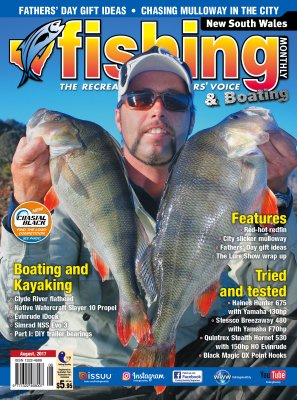Getting ready for red-hot reddy action by Wayne Dubois
 If you're into redfin fishing you should be excited - we are currently experiencing some of the best redfin action in NSW and Victoria for many years. Thinking about how they almost disappeared from most places for several years and then suddenly came back in massive numbers all over these two states will do your head in.
If you're into redfin fishing you should be excited - we are currently experiencing some of the best redfin action in NSW and Victoria for many years. Thinking about how they almost disappeared from most places for several years and then suddenly came back in massive numbers all over these two states will do your head in.
Like most things in fishing, the reasons why redfin almost disappear and then reappear in the thousands will continue to keep us guessing. Let's not dwell on that and let's look at how to make the most of a good thing while it lasts, as just like last time, no one knows when these redfin are going to virtually disappear from our waterways again.
I am yet to have an experience while redfin fishing where bait has out-fished lures. The reason for this is that redfin are a schooling fish and an aggressive schooling fish at that. Schooling predatory fish don't muck around when there is an easy meal trying to swim by. Due to their competitive nature they fight for the first bite at the cherry and then fight over that cherry no matter who gets the first bite. Anglers can exploit this characteristic by using lures and sometimes flies.
COOL MONTH STRATEGIES
In the cooler months of the year in large impoundments redfin will form in massive pre-spawn schools and move into deep water, mostly well away from the banks. This is probably bad news for land-based anglers, but it's great news for anglers with some sort of vessel - rather than being spread out all over the lake in all water depths like they are in the warmer months, they are now concentrated in much bigger schools and are all sitting at approximately the same depth. This makes them far easier to locate.
In the large lakes we find the schools tend to hover between 30ft and as deep as 80ft, but we find the most consistent holding depth is around 40ft. Start at this depth and work your way deeper or shallower until you find where they are holding on any given day.
Ice jigs, rubber vibes, heavily weighted plastics and blades are all you need for consistent redfin action in the cooler month. If you don't see the fish on your sounder, you can find the fish with rubber vibes, blades or heavily weighted plastics.
Cast these lures away from the boat and hop them back to the boat making sure to stay in touch with your lure on the drop in between lifts. This is when almost all of the hits occur (refer to my article on bottom bouncing for golden perch in the March 2017 issue of NSWFM or online for a more detailed description of this technique). Once you find a school with your lures, hold off from them and continue to cast to them from a distance so that you don't scare them. If they aren't easily spooked, get directly over the top of them and vertically jig with the ice jigs.
Once you're directly over the fish, free spool the ice-jig all the way to the bottom and then wind up the slack in your line until your rod is horizontal with the water. Sharply lift your tip anywhere between 10-100cm - the amount that you lift the rod is not as important as making sure that the lift is very sharp and quick. A short sharp lift will put far more action on the ice-jig than a slow, gentle lift, which will do very little to impart action on the lure.
After each lift I like to wait until my jig has free fallen back to its original position then I repeat the procedure over and over again. When the redfin are tough to entice making sure your jig lightly touches the bottom in between lifts can sometimes be the difference between fish and no fish.
The most important factor to understand when using this technique and any hopping technique is that almost all of the hits (90%+) will be while the jig or lure is free falling back down after a short sharp lift. It's critical that you stay in contact with your lure while it's free falling so that as soon as you feel a hit you can strike and hook the fish. Put simply, if you don't strike, you won't hook many fish.
To take the ice jigging technique a step further; attach a marabou jig and an unweighted or lightly weighted soft plastic or flashy fly around a metre above your ice-jig, as this will increase your catch rates and give you the added bonus of the odd double and even triple hook-up. The main reason I employ the extra plastic, jig or fly is that quite often redfin schools will hold over and in thick weed beds. I found if the ice jig ends up fouled with weed, it's not the end of the world as you still have the weed-free plastic, jig or fly to tempt fish into striking.